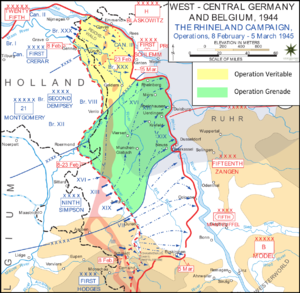Operation Blockbuster
This article needs additional citations for verification. (February 2011) |
| Operation Blockbuster | |||||||
|---|---|---|---|---|---|---|---|
| Part of the Western Allied invasion of Germany in the Western Front of the European theatre of World War II | |||||||
 Operation Blockbuster (yellow) | |||||||
| |||||||
| Belligerents | |||||||
|
|
| ||||||
| Commanders and leaders | |||||||
|
|
| ||||||
Operation Blockbuster was the completion of the larger Operation Veritable by the First Canadian Army, reinforced by the XXX Corps from the British Second Army from late February to early March, 1945. Veritable had been slower and more costly than expected and the Canadian commander, General Harry Crerar, had decided on a fresh start for the operation. Three British and Canadian divisions advanced south-eastwards, capturing unprepared German positions in the , before advancing on Xanten. They linked up with the Ninth US Army at Berendonk, near Geldern on 3 March.
Battle honours[]
Attached to the 10th Canadian Infantry Brigade, 4th Canadian (Armoured) Division, the Canadian infantry and armoured regiments to earn battle honours for actions during Operation Blockbuster, emblazoned on their regimental colours as The Hochwald, include:
- The Algonquin Regiment
- The Argyll and Sutherland Highlanders of Canada
- The Lake Superior Regiment (Motor)
- The Lincoln and Welland Regiment
- Sherbrooke Fusiliers Regiment
- South Alberta Regiment
- The South Saskatchewan Regiment
In popular culture[]
The Battle of the Hochwald Gap was the topic of an episode of the documentary series Greatest Tank Battles. Veterans on both sides gave testimonies on the violence of the campaign. The Canadians in particular spoke of the tenacity of German soldiers in the Rhineland while former German soldiers gave testimonies on their own experiences with the Canadians.
Further reading[]
- Ellis, Major L. F. & with Warhurst, Lieutenant-Colonel A. E. (2004) [1st. pub. HMSO 1968]. Butler, J. R. M. (ed.). Victory in the West: The Defeat of Germany. History of the Second World War United Kingdom Military Series. II. Naval & Military Press. ISBN 978-1-84574-059-7.
External links[]
| Wikimedia Commons has media related to Operation Blockbuster. |
- "The Hochwald Gap" at Canadianheroes.org
- Official history of the Canadian Army (Chapter XIX): The Battle of the Rhineland. Part II: Operation "BLOCKBUSTER"
See also[]
Footnotes[]
- Western European Campaign (1944–1945)
- Battles of World War II involving Canada
- Military operations of World War II involving Germany
- Land battles and operations of World War II involving the United Kingdom
- World War II stubs